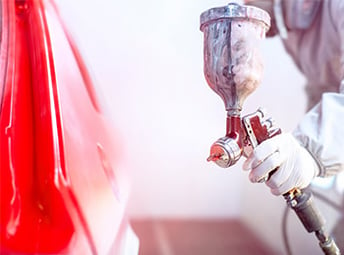
Sustainability has become a common buzzword within the manufacturing industry, but there are countless applications within any given industry. Of particular concern in today’s economic and ecological climate are air emissions from the automotive industry – particularly from the chemicals used when painting or applying other coatings. So what does sustainability mean when we talk about automotive coating operations?
First off, let’s establish a working definition of sustainability, which in itself can be a challenge within the manufacturing sector. A commonly accepted definition of sustainability was popularized by the 1992 Brundtland Report highlighting the interconnectedness of the economy, the environment, and the social spheres. Among other things, the report sought to shed light on “how to meet our needs without compromising the needs of future generations.”
Fast-forward to today: sustainability issues are an increasing concern for governments and citizens; protecting the environment from further degradation and meeting consumer demand are therefore top concerns for automotive manufacturers. Indelibly, this has had an important impact on the processes and technology automotive manufacturers use when it comes to applying adhesives, paints, and coatings. These chemical categories are a primary source of air emissions from automotive facilities, and EHS managers have had to contend with stricter rules on hazardous air pollutants (HAPs) and volatile organic compounds (VOCs), on top of the growing demands by the public for environmentally friendly products.
This article will focus in on how your triple bottom line is affected by the choices you make in coatings, paints and adhesives – and share some insights on how to improve your sustainability projects.
How to Reduce Air Emissions: Switching to Lower HAP or Low-VOC Automotive Coatings
Seeing demand from automotive manufacturers, as well as other industries, coating suppliers have been adapting their formulations and experimenting with new products to meet the desire for more sustainable coatings.
One example of this is the shift from solventborne to waterborne coatings. Since the 2000s, waterborne coatings became more commonplace in the automotive industry. Waterborne paints are composed of up to 80% water and have a lower emission of VOCs. The importance of this lies in the fact that the majority of VOCs are emitted during the manufacturing phase and more specifically during the painting process, which is responsible for 95% of emissions from a car’s entire life cycle. While waterborne coatings contain a smaller amount of solvent, they are a better choice for the environment. There are also other benefits such as generating less waste and being easier to blend because there is no specialized machinery needed for the mixing process. Besides performing as well as solventborne paints in terms of durability, waterborne coating is also considered by many to enhance appearance.
The push towards sustainability means coating suppliers need to innovate. Innovation is not only a way to stay competitive, it also means bringing more value to customers and enhancing your brand image. Coating manufacturers, such as DSM, have been developing new formulas made of resin technology and other bio-renewables. DSM’s Decovery is a great example of this: it’s made of plant-based acrylic, using 60% renewable raw materials. The downside is that there does not appear to be an equivalent of Decovery being used in the automotive industry currently. Still, since the global automotive coating industry is projected to reach $11.34 billion by 2026, due to the dominance of the Asian market, there is much incentive to continue investing in R&D to develop eco-friendly alternatives, especially as Asian millennials are demanding more energy efficient, low carbon footprint products.
Focusing on sustainability is also a viable option due to lowering costs related to energy usage, solvents, waste shipments. While making the switch to manufacturing more sustainable products may present more up-front costs, it can lead to a return on investment (ROI), especially in the face of lower supplies of raw materials such as TiO2.
Coatings and Health & Safety: Keeping Automotive Employees Safe
Prioritizing your employee’s health and safety is an essential part of any sustainability plan. In regard to coatings, switching to greener chemical materials will reduce employee exposure to HAPs, VOCs and particle pollution (dust), which can cause serious long-term health problems. The Occupational Health and Safety Administration (OSHA) reports that even when employees use proper protective gear and the facility is equipped with a proper ventilation system, constant contact can still result in occupational asthma, lung problems and other health issues. Additionally, prioritizing employee health and well-being means fewer workplace incidents, thus fewer legal or workers compensation issues, greater productivity and contributes to a positive brand image.
How to Make Coating Emissions Management Accurate and Simple
Since one of the greatest challenges in sustainability for the automotive sector is being able to quantify and measure sustainability projects, most manufacturers have turned to some form of sustainability software that can assist with their goals.
For instance, having a software that automates your tracking of HAPs, VOCs, Greenhouse Gases, and other criteria air emissions, as well as helping you report them to your regulators or shareholders, can dramatically improve your ability to make more sustainable choices when looking at your coating operations and choosing coatings to apply.
In addition to giving you the raw data you need to make intelligent decisions, it reduces the risk of human data errors, and the cost of time spent crunching numbers. The more productivity and ROI you can squeeze from your sustainability projects, the more these savings can snowball into larger and more profitable sustainability goals.
You’ll also be more protected from noncompliance risks, and have tools to help you to stay compliant with EPA’s regulatory reports, such as Tier II, MACT, NESHAP. One special feature of ERA’s software is that can automatically upload vendor data, allowing greater precision in reporting. Some systems are equipped with automated alerts, accessible on mobile devices, notifying you if any customized thresholds are reached, which ensures that you stay compliant.
Since you want to set yourself up for success, investing in a SAAS (software as a service) software will help you in achieving your goals by increasing accuracy in reporting, which in turn will minimize your chances of receiving hefty non-compliance fees. This will free up time and money that can be diverted to other projects such as investing in R&D, “greening” your facility and initiating sustainability projects in your local community.
To learn how to address common challenges and find solutions to meeting air quality compliance in the surface coating industry, join ERA and Trinity Consultants on March 26, 2020 at 2:00 pm EST.
Further reading
https://www.mcgill.ca/sustainability/files/sustainability/what-is-sustainability.pdf
https://en.wikipedia.org/wiki/Triple_bottom_line
https://www.paintsquare.com/news/?fuseaction=view&id=9834
https://www.paint.org/coatingstech-magazine/articles/brief-history-automotive-coatings-technology/
https://www.pcimag.com/articles/98699-biobased-resin-technology-helping-define-high-performance
This Blog Was Co-Authored By:



March 5, 2020


Comments